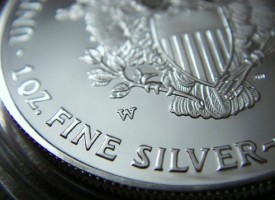On the heels of some fierce trading this week in the dollar, gold and silver, below is an extremely important update on the war that is raging in the gold and silver markets, plus a bonus note on the surprising and key events from this week.
The following charts are from Jason Goepfert at SentimenTrader.
Commercial Short Positions In Gold Near All-Time Highs
King World News note: Below you can see the commercial hedgers have added aggressively to their short positions in the gold market this week, as you can see from the chart below. That does not mean that the price of gold cannot continue heading significantly higher in the short-term, but it does raise a caution flag.

The next chart takes a longer-term look at gold…
In Volatile Markets, Is Wealth Preservation King?
 Sponsored
Sponsored
King World News note: Sometimes it’s important to take a step back and look at the big picture in the gold market. Looking at the 23-year chart below, the commercials are now very close to all-time record short positions in the gold market (see remarkable 23-year chart below).

As For Silver…

Commercial Short Positions In Silver Near All-Time Record High!
King World News note: Below you can see the commercial hedgers position in the silver market market also remains near all-time highs in terms of their overall shorts (see 23-year chart below).

The commercial shorts are at a level that raises serious concern. In fact, the commercials are now very close to their largest cumulative short position in history. The last time the commercials held this large of a short position in silver was in 2004. Again, that does not mean that the price of silver cannot head significantly higher in the short-term.
What is important to note on the chart above is that the last time the commercials were this short silver there was a brief 12.7 percent pullback in the price of silver, but over the next 18 months the price of silver more than doubled from the low of that pullback in 2004. So from late November of 2004, when the price of silver fell to about $6.70, the price of silver soared to $14.31 by early May of 2006. Nevertheless, the commercials now have historic short bets against silver and that is something that traders and investors should watch closely.
It would appear that the endless talk about the massive commercial short positions in both metals coupled with the bullish advance coming on the heels of a brutal 5-year cyclical bear market is keeping a healthy level of “fear” in the early stages of the newest leg of the bullish advance. So it will be very interesting to see how gold and silver trade from current levels in the days and weeks ahead.
Also of importance…
From Peter Boockvar:
Succinct Summation of the Week’s Events:
Positives:
1)July saw a new record high in the amount of US job openings. They totaled 5.87mm in the month, about 240k more than expected and up from 5.64mm in June. The level of hiring’s rose to a 4 month high but are 63k below that March level when there was 200k less job openings. This again points to the supply side (or lack thereof) of the labor market remaining a drag. The amount of those quitting their jobs was basically flat m/o/m and the quit rate at 2.1% was unchanged but holding at the average seen year to date.
2)Initial jobless claims fell to 259k from 263k last week. The estimate was 265k. This brings the 4 week average to 261k from 263k last week. Continuing claims, delayed by a week, fell by 7k after rising by 6k in the week prior.
3)Mortgage apps were up a touch w/o/w. Purchases rose for a 2nd week off its lowest level since February by 1.2% and are up 7% y/o/y. Refi’s were up by .7% w/o/w and still a very good 43% y/o/y.
4)In China, CPI in August slowed to a rate of gain of 1.3% y/o/y, down from 1.8% in July and below the forecast of 1.7%. It’s the slowest increase since October but was SOLELY driven by a sharp slowdown in food price increases. They slowed to 1.3% y/o/y from 3.3% in July. Non food prices were unchanged at 1.4%. PPI fell .8% y/o/y which is the least negative in two years as commodity prices have stopped falling and comparisons get much easier.
5)Chinese exports in August were lower by 2.8% y/o/y but that was a bit better than the estimate of a drop of 4%. With a weaker yuan, exports rose by 5.9% in yuan terms. Exports to the US were flat y/o/y, mixed to Asia and up 2.4% to the EU. On the import side in dollar terms they rose by 1.5% y/o/y which was well better than the forecast of a decline of 5.4%. That is actually the first increase since October 2014. I don’t know whether this is due to a crackdown on fake invoices or something else but imports from Hong Kong ‘only’ rose by 14.3% y/o/y. I say ‘only’ because they were up by 123% in the month prior. UK imports were up 26% y/o/y thanks to the weaker pound.
6)China’s private sector weighted PMI services index rose to 52.1 in August from 51.7. The average year to date is 51.9.
7)PMI’s in Hong Kong, Singapore and India were up m/o/m.
8)Regular pay in Japan in July rose .4% y/o/y, modest but an improvement from no change in June and it’s the best print since March.
9)EU retail sales were up by 1.1% m/o/m, twice the estimate.
10)UK services index in August jumped to 52.9 from the vote panic print of 47.4 in July. The estimate was 50.
Negatives:
1)Air is seeping out of the epic global bond bubble that may have saw its final blow off right after Brexit. This leaking started in Japan last month when the BoJ started buying less longer term debt over worries with what they were doing to the yield curve. We then can move to the ECB and worry that they are running out of bonds to buy and even if they expand, they will clearly be stretching. The Fed may raise in September but the 2 yr note yield is FLAT on the week notwithstanding comments today from Rosengren. Long end Treasury yields though are following JGB’s and European’s sovereign bonds higher. As for the BoE, the 10 yr gilt yield has gotten back all of what it lost post Brexit and then some and is at a two month high. We are all in this bubble together and what goes around will come around to us all. Calling the end of the bond bull market we know has been a fools game for MANY years. However, if you put aside your thoughts on growth and inflation which have been the two main factors for all the “bull market is over” calls over the years and just look at the logistical limits being reached by central banks, I believe it can be called more accurately now.
2)The ISM non manufacturing index for August was weak, falling to 51.4 from 55.5 in July and that was well below expectations of 54.9. This is the worst print since February 2010 when it was at 50.8. New orders sunk by 9 pts to just above 50 at 51.4. Backlogs fell back below 50 at 49.5 vs 51 in July. Employment was barely above 50 at 50.7, down .7 pts. Export orders (only some service co’s report exports) plunged by 9 pts to 46.5. Of the 18 industries surveyed, just 11 saw growth vs 15 in July. The ISM said “the majority of the respondents’ comments indicate that there has been a slowing in the level of business for their respective companies.”
3)The Fed creation called the Labor Market Conditions index was negative for the 7th month in the past 8.
4)After the inventory destocking we saw in Q2, wholesale inventories were again flat in July vs the estimate of a rise of .1%. Because sales fell by .4% instead of rising by .2% as forecasted, the inventory to sales ratio rose to 1.34 from 1.33. In particular, the I/S ratio for auto’s rose to 1.84, matching the highest level since May 2009.
5)Eurozone services PMI was revised down to 52.8 from 53.1 initially and down from 52.9 in July.
6)German Exports dropped by 2.6% m/o/m, well worse than the estimate of up .4%. Exports to the EU were in particular weak and is likely in response to the initial post Brexit panic attack. Imports also dropped by .7% instead of rising by .5%.
7)The German July IP figure was soft. Production dropped 1.5% m/o/m, well below the estimate of up .1% and the y/o/y decline was 1.2%. This was only partially offset by a three tenths upward revision to June.
8)German factory orders in July rose .2% vs the estimate of up .5%.
9)The manufacturing component of French IP was down by .3% m/o/m vs the estimate of up .7%.
10)In the immediate response to the UK vote, July UK manufacturing IP fell .9% w/o/w, three times the estimate while the y/o/y increase was .8%, about half the estimate. The August data seen so far has improved.
11)Chinese FX reserve stash fell to $3.185T in August from $3.2T in July. That was below the estimate of $3.19T and is the smallest slush fund in almost five years. This pile was over $4T two years ago.
12)Japan’s services PMI fell back below 50 at 49.6 from 50.4 in July.
***Also just released: Stocks Tumble, Along With Crude Oil And Bonds But This Is Even More Important CLICK HERE.
© 2016 by King World News®. All Rights Reserved. This material may not be published, broadcast, rewritten, or redistributed. However, linking directly to the articles is permitted and encouraged.







